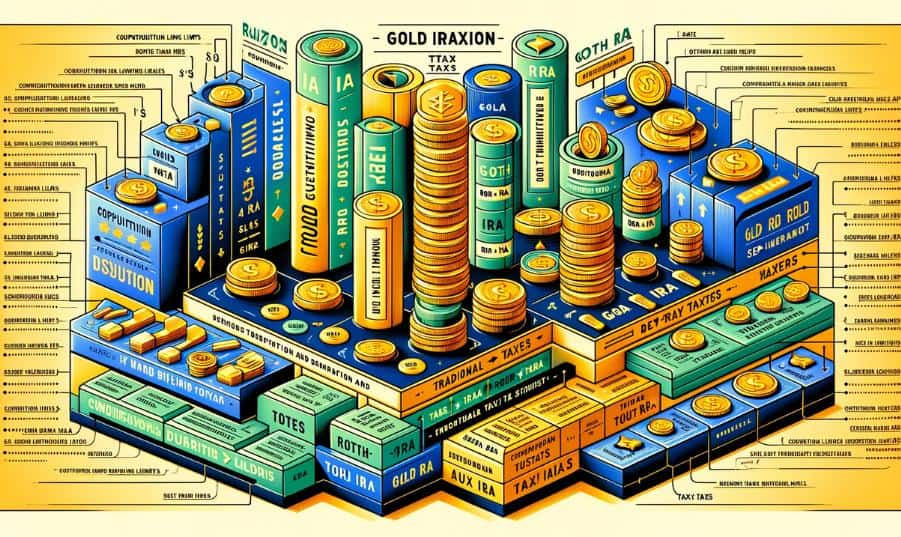Is a Gold IRA a Good Investment?

A Gold Individual Retirement Account (IRA) is an investment vehicle that allows individuals to diversify their retirement savings portfolio by including physical precious metals like gold, silver, platinum, and palladium. Unlike traditional IRAs, which are typically composed of stocks, bonds, and mutual funds, a Gold IRA provides a unique avenue for safeguarding wealth, particularly in times of economic uncertainty. The allure of gold and other precious metals lies in their ability to act as a hedge against inflation and as a safe haven during market downturns.
In recent years, the popularity of Gold IRAs has surged, driven by their potential for long-term growth and financial stability. As a physical asset, gold offers a tangible sense of security, making Gold IRAs an attractive option for investors looking to balance their retirement portfolios with a safe haven asset.
Key Highlights
- Diversify Your Portfolio: Understand how adding a Gold IRA to your retirement plan can offer unique benefits, including portfolio diversification and protection against market volatility.
- Tax Advantages & Implications: Explore the significant tax benefits of Gold IRAs and how they compare to traditional retirement accounts, aiding in long-term wealth growth.
- Safe & Secure Investment: Learn about the secure storage solutions for your precious metals and the importance of choosing IRS-approved custodians and depositories.
How Gold IRAs Work
Gold IRAs (see a list of the best here) are specialized self-directed IRAs that allow individuals to hold physical gold and other precious metals. Here’s how they function:
- Types of Gold IRAs:
- Traditional Gold IRAs: Funded with pre-tax dollars, offering tax-deferred growth.
- Roth Gold IRAs: Contributions are made with after-tax dollars, allowing for tax-free withdrawals during retirement.
- SEP Gold IRAs: Suitable for self-employed individuals and small business owners, allowing them to invest in precious metals within a Simplified Employee Pension plan.
- Finding a Custodian: Unlike regular IRAs, Gold IRAs require an IRS-approved custodian to manage the account. Custodians are responsible for purchasing and storing the physical metals, ensuring compliance with IRS regulations.
- Funding the Gold IRA: Investors can fund their accounts through:
- Annual contributions within the IRS limits.
- Rollovers from existing 401(k)s or traditional IRAs.
- Buying Approved Gold: The IRS has specific requirements for the purity and authenticity of the precious metals included in a Gold IRA. Approved metals typically include certain bullion coins and bars that meet these standards.
Types of Precious Metals in Gold IRAs

Gold IRAs are not limited to just gold; they can include a variety of precious metals, each offering its own unique benefits:
- Gold: The cornerstone of most Gold IRAs, available in the form of bullion, coins, and bars. Gold is renowned for its ability to maintain value and act as a safe haven during economic instability.
- Silver, Platinum, and Palladium: These metals can also be included in Gold IRAs, offering additional diversification. Like gold, they are valued for their rarity and industrial uses, adding another layer of portfolio diversification.
- IRS Regulations: All metals in a Gold IRA must adhere to specific purity standards. For instance, gold must be 99.5% pure, while silver must be 99.9% pure. The IRS also stipulates certain approved forms of these metals, such as certain coins and bullion bars, ensuring the integrity and value of the IRA.
By incorporating these precious metals into a retirement portfolio, investors can leverage their unique properties to enhance their portfolio’s resilience and growth potential, making a Gold IRA a compelling component of a well-rounded retirement strategy.
Advantages of Investing in a Gold IRA
Investing in a Gold IRA comes with a myriad of advantages, making it a standout choice for individuals seeking a robust, diversified retirement portfolio. Here are the key benefits:
- Tax Benefits: Similar to traditional IRAs, Gold IRAs offer significant tax advantages. Contributions to a Traditional Gold IRA may be tax-deductible, and the investment grows tax-deferred. Roth Gold IRAs provide tax-free growth and withdrawals, making them an attractive option for long-term growth.
- Portfolio Diversification: By including physical gold and other precious metals, Gold IRAs offer a high degree of diversification. This can protect investors against market volatility, as the performance of precious metals often inversely correlates with stocks and bonds.
- Protection Against Inflation: Gold has historically been a reliable inflation hedge. Its value tends to increase when the cost of living rises, making it an excellent choice for preserving purchasing power over time.
- Long-Term Growth Potential: Although the price of gold can fluctuate in the short term, it has maintained its value over the long term. Including gold in a retirement portfolio can provide a stable foundation for growth, acting as a safeguard against economic downturns and market instability.
Risks and Disadvantages of Gold IRAs
While Gold IRAs offer unique advantages, they also come with certain risks and disadvantages that investors should consider:
- Market Volatility: The price of gold and other precious metals can be highly volatile. Short-term fluctuations in the market can affect the value of a Gold IRA, potentially leading to losses.
- Fees and Expenses: Gold IRAs typically involve several types of fees, including storage fees, enrollment fees, and custodian charges. These fees can add up over time, affecting the overall return on investment.
- Theft and Fraud Risks: Although rare, there’s a risk of theft and fraud when investing in physical assets like gold. Choosing a reputable custodian and insured storage facility can mitigate these risks.
- Funding Restrictions: There are limits on how much can be contributed to a Gold IRA each year. Additionally, investors cannot add gold they already own to their IRA; all transactions must be handled by the custodian.
Gold IRA Storage Solutions
The proper storage of physical gold and other precious metals is a critical component of a Gold IRA. Here’s how it works:
- IRS-Approved Storage Facilities: Physical gold in a Gold IRA must be stored in an IRS-approved depository. These facilities ensure the safety and security of the precious metals, protecting them from theft or loss.
- Home Storage Risks: While some companies may advertise home storage options for Gold IRAs, this approach is not approved by the IRS and poses significant risks. Storing gold at home can lead to theft and may attract IRS penalties and audits.
- Choosing the Right Depository: When selecting a depository for your Gold IRA, consider factors like security, location, and costs. Some custodians may offer a choice of depositories, allowing investors to select the one that best fits their needs.
By understanding and navigating the storage requirements for a Gold IRA, investors can ensure that their precious metals are held securely, maintaining the integrity and value of their retirement savings.
Rolling Over Traditional IRAs to Gold IRAs
Transitioning from a traditional IRA to a Gold IRA can be a strategic move for diversifying your retirement portfolio. Here’s how the rollover process typically works:
- Open a Gold IRA: The first step is to establish a Gold IRA through a trusted provider. Ensure that they offer the type of Gold IRA (Traditional, Roth, or SEP) that aligns with your financial goals.
- Appoint a Custodian: A reputable, IRS-approved custodian is essential for managing the transactions and storage of the physical precious metals in your Gold IRA.
- Decide the Transfer Amount: Consult with a financial advisor to determine how much of your traditional IRA funds to transfer. Be mindful of the annual contribution limits and any minimum investment requirements set by the Gold IRA provider.
- Initiate the Rollover: Direct the custodian of your traditional IRA to transfer the chosen amount to your Gold IRA. This process should be handled with care to avoid potential taxes or penalties.
Comparing Gold IRAs with Other Investment Options
When evaluating a Gold IRA against other investment avenues, it’s crucial to consider the distinct characteristics of each option:
- Traditional and Roth IRAs: These IRAs primarily invest in stocks, bonds, and mutual funds. While they offer significant tax advantages, they might not provide the same level of protection against inflation or economic downturns as a Gold IRA.
- Diversification Benefits: A Gold IRA can complement traditional investment vehicles by adding a layer of security. Gold’s historical negative correlation with stocks and bonds makes it a valuable addition to a diversified investment portfolio.
- Tax Implications: Both Gold IRAs and traditional retirement accounts offer tax benefits, but the specifics (tax-deductible contributions, tax-deferred growth, tax-free withdrawals) vary depending on the account type and your individual circumstances.
- Long-Term Investment Perspective: Consider your investment horizon and risk tolerance. Gold IRAs can be an excellent choice for long-term growth and wealth preservation, especially during times of economic uncertainty.
FAQs about Gold IRAs
Q: What are the tax implications of investing in a Gold IRA?
- A: Gold IRAs offer similar tax benefits to traditional IRAs. Contributions to a Traditional Gold IRA may be tax-deductible, and the investment grows tax-deferred. Roth Gold IRAs provide tax-free growth and withdrawals.
Q: Can I store my Gold IRA assets at home?
- A: No, the IRS requires that precious metals in a Gold IRA be stored in an approved depository. Home storage is not permitted and can lead to penalties and audits.
Q: Are there annual contribution limits for Gold IRAs?
- A: Yes, Gold IRAs have the same annual contribution limits as traditional IRAs. The specific amount can vary each year and may be different for individuals over a certain age.
Q: What types of gold can be included in a Gold IRA?
- A: A Gold IRA can include gold bullion, coins, and bars that meet specific purity and authenticity requirements set by the IRS. Other precious metals like silver, platinum, and palladium can also be included.
By carefully considering these frequently asked questions, investors can gain a better understanding of how Gold IRAs function and how they can fit into a comprehensive retirement planning strategy.
Conclusion
In conclusion, a Gold IRA offers a unique investment opportunity, blending the tangible security of physical precious metals with the tax advantages of traditional retirement accounts.
While it comes with its own set of risks and considerations, including market volatility and storage logistics, the benefits of portfolio diversification, inflation protection, and long-term growth potential make it an attractive option for many investors.
As with any investment decision, it’s crucial to conduct thorough research, consult with financial experts, and consider your individual financial goals and risk tolerance before diving into the world of Gold IRAs.





















